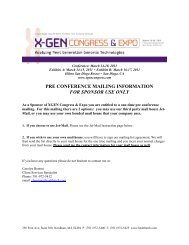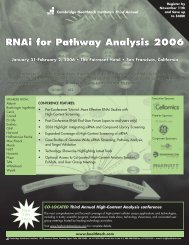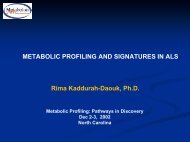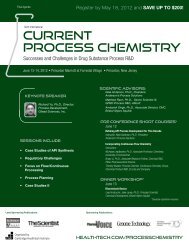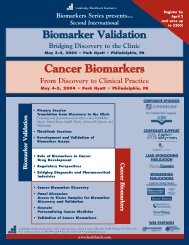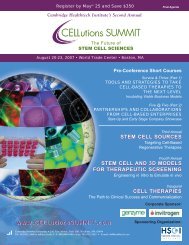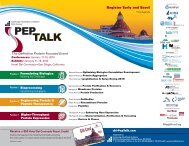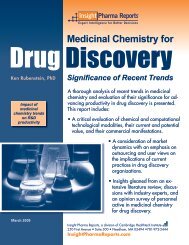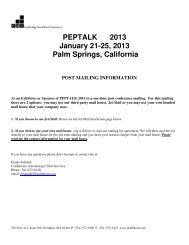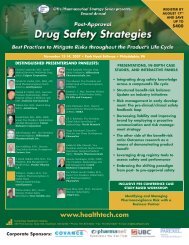Structure-Based Drug Design Conference Final Brochure.pdf
Structure-Based Drug Design Conference Final Brochure.pdf
Structure-Based Drug Design Conference Final Brochure.pdf
- No tags were found...
Create successful ePaper yourself
Turn your PDF publications into a flip-book with our unique Google optimized e-Paper software.
<strong>Final</strong> Agenda<br />
Cambridge Healthtech Institute and Bio-IT World Present the Eleventh Annual<br />
<strong>Structure</strong>-<strong>Based</strong><br />
<strong>Drug</strong> <strong>Design</strong><br />
Rational<br />
June 8-10, 2011 • Royal Sonesta Hotel Boston • Cambridge, MA<br />
Molecular<br />
Approaches to Targeted<br />
Therapeutics — From<br />
Fragments to Biology<br />
Register by<br />
March 11, 2011<br />
and Save<br />
up to $350!<br />
<strong>Conference</strong> Highlights:<br />
• Protein Flexibility<br />
• Fully Synthetic<br />
Protein-Protein<br />
Interaction Inhibitor<br />
• Fragment-to-Lead<br />
Optimization<br />
• High Performance<br />
Computing and<br />
Collaborative <strong>Drug</strong> <strong>Design</strong><br />
• State-of-the-Art Molecular<br />
Dynamics Simulations<br />
healthtech.com/SBD<br />
Keynote Speaker:<br />
Millisecond-Long Molecular<br />
Dynamics Simulations of Proteins<br />
on a Special-Purpose Machine<br />
David E. Shaw, Ph.D.,<br />
Chief Scientist,<br />
D. E. Shaw Research<br />
Dinner Short Course:<br />
June 8, 2011<br />
Identification of <strong>Drug</strong>gable Sites for<br />
Protein-Protein Interaction Targets<br />
Co-Located with:<br />
Next-Gen Kinase Inhibitors:<br />
Across Multiple Therapeutic Areas<br />
June 6-8, 2011<br />
healthtech.com/KIN<br />
Corporate Sponsors:<br />
Corporate Support<br />
Sponsors:<br />
Official<br />
Publication:<br />
Organized by:<br />
Cambridge Healthtech Institute
WEDNESDAY, JUNE 8<br />
12:00-1:20 pm Main <strong>Conference</strong> Registration<br />
STRUCTURE-BASED KINASE INHIBITOR DESIGN<br />
& KINASE SELECTIVITY<br />
(Shared session with Next-Gen Kinase Inhibitors <strong>Conference</strong>)<br />
1:10 Chairperson’s Remarks<br />
Andrew C. Good, Ph.D., Distinguished Scientific Fellow, Medicinal<br />
Chemistry, Genzyme Corp.<br />
1:15 Discovery of Crizotinib (PF-02341066)-A c-Met/ALK Dual<br />
Inhibitor for Oncology Applications<br />
Jean Cui, Ph.D., Associate Research Fellow, Oncology Medicinal<br />
Chemistry, Pfizer, Inc.<br />
Crizotinib (PF-02341066) has shown remarkable efficacy for lung cancer<br />
patients with EML4-ALK fusion gene and is currently in Phase III clinical<br />
trials. Crizotinib is created as a c-Met/ALk dual inhibitor using structurebased<br />
drug design in combination with medicinal chemistry principles.<br />
1:45 A Role for Hydration in Interleukin-2 Inducible T Cell<br />
Kinase Selectivity<br />
Ronald Knegtel, Ph.D., Research Fellow I, Molecular Modeling, Vertex<br />
Pharmaceuticals (Europe) Ltd.<br />
A series of Itk inhibitors that achieve selectivity through the introduction<br />
of a single, solvent exposed aromatic nitrogen atom without direct<br />
interactions with the enzyme is reported. By analyzing active site<br />
hydration using WaterMap, the selectivity profile can be explained in<br />
terms of the replacement of a thermodynamically unfavorable water<br />
molecule by the inhibitor and improved hydration of the bound ligand.<br />
This hydration site was successfully used to enrich virtual screening<br />
results in their content of selective Itk inhibitors.<br />
2:15 Overcoming <strong>Drug</strong>-Resistant Mutations in Kinase <strong>Drug</strong><br />
Discovery: Applying Lessons from Ponatinib (AP24534)<br />
David C. Dalgarno, Ph.D.,Vice President, Research<br />
Technologies, ARIAD Pharmaceuticals, Inc.<br />
Ponatinib (AP24534) is a novel BCR-ABL inhibitor that<br />
inhibits both native and mutant BCR-ABL, including the<br />
T315I gatekeeper mutation, and hence acts as a pan-BCR-<br />
ABL inhibitor. We recently analyzed the structural basis for<br />
this pan-BCR-ABL activity. Here we discuss this analysis and how it can<br />
be applied to other kinase targets exhibiting mutation-based resistance,<br />
and how the lessons from ponatinib can be applied to the design of<br />
other mutant kinase inhibitors.<br />
2:45 <strong>Structure</strong>-<strong>Based</strong> Kinase Sponsored by<br />
Inhibitor <strong>Design</strong> & Kinase Selectivity<br />
Stephen A. Parent, Ph.D., Director of Business<br />
Development, Reaction Biology Corporation<br />
RBC provides drug profiling and screening services using HotSpot<br />
technology, a high-throughput radioisotopic screening platform with<br />
more than 370 kinases. We will describe its application to kinase<br />
inhibitor development and kinase inhibitor selectivity.<br />
3:00 Networking Refreshment Break in the Exhibit Hall with<br />
Poster Viewing<br />
3:30 <strong>Structure</strong>-Guided Fragment-<strong>Based</strong> <strong>Drug</strong> Discovery for<br />
Protein Kinase Targets<br />
Stephen K. Burley, M.D., D.Phil., Distinguished Lilly Research<br />
Scholar, Lilly Biotechnology Center, Eli Lilly and Company<br />
4:00 How Molecular Dynamics Simulation May be Applied in<br />
Structural <strong>Based</strong> <strong>Design</strong> of Kinase <strong>Drug</strong>s<br />
Yibing Shan, Ph.D., Senior Scientist, Chemistry and Biology, D. E. Shaw<br />
Research<br />
The understanding of the extensive conformational heterogeneity of<br />
protein kinases is crucial to the understanding of kinase drugs’ binding<br />
and specificity. To this end, long molecular dynamics (MD) simulations,<br />
which for the first time reached the relevant timescale of micro- to millisecond,<br />
may prove a powerful tool. Our MD study of Abl, Src, and EGFR<br />
kinases will be discussed as examples of such effort in its early stage.<br />
4:30 Recent experience establishing a new lead ID capability<br />
to pursue oncology kinase targets.<br />
Hans-Peter Biemann, Ph.D., Associate Scientific Director, In vitro Biology,<br />
Genzyme Corporation<br />
Genzyme’s small molecule discovery unit has incorporated fragmentbased<br />
and x-ray structure-assisted technologies over the last three<br />
years. Ligands of 150-250 Daltons have undergone structure-assisted<br />
elaboration to identify novel potent and selective inhibitors of tyrosine<br />
and ser/thr kinases, including Pim-1. One program progressed a<br />
tyrosine kinase to late lead optimization in 2.5 years and newer projects<br />
have productively commenced outside of the kinase and oncology<br />
sectors. This evolution of our HTS-based drug discovery unit to a multiplatform<br />
format enables us to address a number of target classes more<br />
expediently than before.<br />
5:00 Longstanding Kinase Contributor Panel: <strong>Structure</strong>-<strong>Based</strong><br />
Kinase Inhibitor <strong>Design</strong><br />
Topic: Insights correlating kinase selectivity and toxicity<br />
Andrew C. Good, Ph.D., Distinguished Scientific Fellow, Medicinal<br />
Chemistry, Genzyme Corp.<br />
Ravi G. Kurumbail, Ph.D., Research Fellow and Structural Biology<br />
Laboratory Head, Pfizer, Inc.<br />
Dirksen Bussiere, Ph.D., M.B.A., Director, Structural Chemistry, Novartis<br />
Institutes for BioMedical Research<br />
5:00-6:00 Registration for Dinner Short Course<br />
Wednesday Evening, June 8, 2011<br />
Dinner Short Course*<br />
6:00-9:00 pm Identification of <strong>Drug</strong>gable Sites for Protein-<br />
Protein Interaction Targets<br />
Despite the growing number of examples of small molecule<br />
inhibitors that disrupt protein-protein interactions (PPIs), the<br />
origin of druggability is poorly understood. This course is<br />
designed to demonstrate the use of computational methods<br />
to determine the most likely structure of the complex formed<br />
by interacting proteins, identify potentially druggable sites in<br />
the interface, determine whether the target is druggable, and<br />
provide information on potential ligands. Participants will study a<br />
number of targets using web-based software (including PIPER and<br />
ClusPro, currently the best protein docking tools available) on their<br />
laptops.<br />
Course Instructors:<br />
Dima Kozakov, Ph.D., Research Assistant Professor, Departments of<br />
Biomedical Engineering, Boston University<br />
Dmitry Beglov, Ph.D., Senior Research Scientist, Structural<br />
Bioinformatics Laboratory, Boston University<br />
Ryan Brenke, Ph.D., Postdoctoral Research Associate,<br />
Structural Bioinformatics Laboratory and Department of Chemistry,<br />
Boston University<br />
David R. Hall, Ph.D. student, Department of Biomedical Engineering,<br />
Boston University<br />
*Separate Registration Required<br />
THURSDAY, JUNE 9<br />
8:00 am Morning Coffee<br />
PROTEIN FLEXIBILITY AND DRUGGABILITY<br />
8:25 Chairperson’s Opening Remarks<br />
Woody Sherman, Ph.D., Vice President, Applications Science,<br />
Schrodinger, Inc.<br />
8:30 FAST Prediction of Protein Stability and Flexibility<br />
Donald Jacobs, Ph.D., Associate Professor of Physics,<br />
Physics and Optical Science, University of North Carolina<br />
Funded by NIH R01-GM073082, a novel computational<br />
method based on free energy decomposition and an iterative<br />
self-consistent reconstitution involving network rigidity to<br />
account for non-additivity in conformational entropy due to<br />
correlated motions has been developed. The program, FAST, provides a<br />
Flexibility And Stability Test for proteins that quantifies stability/flexibility<br />
relationships for understanding function. Speed versus accuracy is<br />
optimized for high-throughput screening to test for structure/function<br />
2<br />
healthtech.com/SBD
elationships in mutation studies, substrate binding, pKa predictions,<br />
allostery, protein-protein interactions and protein formulation.<br />
8:55 Predicting Selectivity and <strong>Drug</strong>gability in Small Molecule<br />
<strong>Drug</strong> Discovery<br />
Alan Cheng, Ph.D., Senior Scientist, Chemistry Research &<br />
Development, Amgen, Inc.<br />
<strong>Structure</strong>-based druggability and selectivity analyses<br />
increasingly inform target assessment and setting of lead<br />
optimization strategies in drug discovery. Continuing work<br />
on druggability prediction will be presented in the context of<br />
applying druggability prediction approaches to large numbers of protein<br />
structures. Work on selectivity analysis will be presented in the context<br />
of kinase inhibitor discovery examples from Amgen, and we will show<br />
how a thermodynamics-based selectivity index can help in predicting<br />
biological selectivity.<br />
9:20 Development of a Simple Metric for the <strong>Structure</strong>-<strong>Based</strong><br />
Assessment of Protein <strong>Drug</strong>gability<br />
Emanuele Perola, Ph.D., Research Fellow I, Vertex<br />
Pharmaceuticals<br />
Accurate assessments of target druggability could<br />
significantly reduce the attrition rate in drug discovery<br />
programs. We developed an algorithm to isolate and<br />
characterize the binding pockets of protein targets and<br />
used it to analyze a set of validated drug targets and a diverse set of<br />
proteins with known crystal structures. We identified five parameters<br />
that differentiate the two sets in a statistically significant manner and<br />
derived a set of simple rules that could be applied to estimate the<br />
druggability of prospective targets.<br />
9:45 Improvements in Predicting Sponsored by<br />
Protein-Ligand Binding Energies: Waters,<br />
Protein Flexibility, and Empirical Scoring<br />
Woody Sherman, Ph.D., Vice President, Applications Science,<br />
Schrodinger, Inc.<br />
Recent years have seen significant advancements in<br />
structure-based drug design methods. The inclusion of<br />
explicit waters and protein flexibility have proven to be<br />
critical components of improved protein-ligand scoring. We<br />
will discuss these advances and how they have produced more robust<br />
scoring and have been integrated into the Glide XP empirical scoring<br />
function to significantly improve virtual screening enrichments.<br />
10:15 Networking Coffee Break in the Exhibit Hall with Poster<br />
Viewing<br />
PROTEIN-PROTEIN INTERACTION<br />
10:45 Identification of <strong>Drug</strong>gable Sites for Protein-Protein<br />
Interaction Targets by Computational Fragment Mapping<br />
Dima Kozakov, Ph.D., Research Assistant Professor, Departments of<br />
Biomedical Engineering, Boston University<br />
We have developed computational fragment mapping to identify “hot<br />
spot” regions in protein-protein interfaces. The method accounts for<br />
protein plasticity, and finds energetically favorable sites for fragment<br />
sized probe molecules. Results are presented for protein-protein<br />
interaction targets, including interleukin-2, Bcl-xL, MDM2, HPV-11 E2,<br />
ZipA, TNF-a, NEMO, and eIF4E. We also discuss methods of finding<br />
druggable targets in cancer pathways.<br />
11:10 Induced Fit Modeling with Monte Carlo Techniques:<br />
Protein Energy Landscape Exploration<br />
Victor Guallar, Ph.D., ICREA Research Professor, Life Science<br />
Department, Barcelona Supercomputing<br />
Protein energy landscape exploration (PELE) constitutes a<br />
remarkable advance over conventional techniques to map<br />
protein and protein-ligand dynamics. This method, which<br />
combines protein structure prediction techniques with<br />
a metropolis algorithm, is capable of describing the all-atom ligand<br />
migration pathway and induced fit in approximately 100 hours of CPU.<br />
A more recent developments in protein-ligand and protein-protein<br />
induced fit will be presented.<br />
11:35 Antagonizing the IAP proteins to Induce Programmed<br />
Cell Death in Cancer: A New Therapeutic Approach Utilizing<br />
Protein-Protein Interaction<br />
Kurt Deshayes, Ph.D., Senior Scientist, Department of Early<br />
Discovery Biochemistry, Genentech, Inc.<br />
Inhibitor of apoptosis (IAP) proteins are expressed at<br />
elevated levels in human malignancies and block cell<br />
death in response to diverse stimuli. They are targets for<br />
small molecule cancer therapeutics under current clinical<br />
development. Results from biophysical, chemical, and molecular<br />
biological studies of the mechanism by which binding of small molecule<br />
IAP antagonists leads to cancer cell death will be reported.<br />
12:00 pm Target based lead optimization: Sponsored by<br />
VLifeSCOPE and SATREA<br />
Sudhir A. Kulkarni, Ph.D., Vice President, Discovery<br />
Research, VLife Sciences Technologies Pvt. Ltd.<br />
VLifeSCOPE is a novel target based lead optimization method where<br />
target ligand interactions obtained from scoring function are partitioned<br />
into individual residues in the active site and correlated to the activity<br />
of molecules. VLifeSCOPE provides information on key residues to<br />
be targeted in lead optimization. SATREA is a visualization tool that<br />
provides information on regions of exploitation and avoidance for<br />
achieving specificity of target of interest with respect to other target in<br />
the same family.<br />
12:30 Luncheon Presentations (Sponsorship Opportunities<br />
Available) or Lunch on Your Own<br />
FRAGMENT-BASED DRUG DESIGN<br />
1:30 Chairperson’s Remarks<br />
Roderick Hubbard, Ph.D., Professor, University of York and Vernalis Ltd.<br />
1:35 Practical Concepts in Fragment-to-Lead Optimization<br />
Marcel Verdonk, Ph.D., Director, Computational Chemistry and<br />
Informatics, Astex Therapeutics Ltd.<br />
Fragment-based screening methodologies have become widely used<br />
in drug discovery projects. We will present various practical concepts<br />
that are used at Astex during the process of fragment prioritization and<br />
optimizations. For example, we will discuss the use of Ligand Efficiency<br />
and Group Efficiency measures. In addition, a practical approach will<br />
be presented to significantly improve docking performance during<br />
fragment-to-lead optimization<br />
2:00 Making Decisions in Fragment-<strong>Based</strong> Discovery<br />
Roderick Hubbard, Ph.D., Professor, University of York and<br />
Director, Stuctural Sciences, Vernalis Ltd.<br />
Fragment-based methods are now well established and<br />
generate hits for most targets. A continuing challenge is<br />
making the right decisions during the fragment to lead<br />
evolution stage – which fragment to evolve based on<br />
chemical and target opportunities and how to evolve fragments in the<br />
absence of structure. This presentation will discuss the contribution<br />
of both computational and experimental methods to address these<br />
challenges.<br />
2:30 Applying Integral Equation Sponsored by<br />
Theory to <strong>Structure</strong> <strong>Based</strong> <strong>Design</strong><br />
Jean-François Truchon, Ph.D., Research Scientist,<br />
Chemical Computing Group<br />
Integral equation theories seem attractive for their ability to generate<br />
water and solvated fragment density distributions in enzyme active<br />
sites. They are much less computationally demanding than Molecular<br />
Dynamics and unveil explicit solvent details missing in continuum<br />
models such as Poisson-Boltzmann. We compare a particular flavor,<br />
namely 3D-RISM/KH, to other methods and examine its usefulness in<br />
structure based design and fragment docking.<br />
3:00 Networking Refreshment Break in the Exhibit Hall with<br />
Poster Viewing<br />
3:45 A Computational Approach to Fragment-<strong>Based</strong> <strong>Drug</strong> <strong>Design</strong><br />
Charles H. Reynolds, Ph.D., Senior Director, Discovery<br />
Technologies, Ansaris<br />
We have developed a free energy method for computing<br />
the interaction of small molecule fragments with their<br />
target proteins. This approach is fast relative to traditional<br />
free energy methods and more accurate than traditional<br />
modeling methods that only compute interaction energies based on<br />
one, or a small number, of configurations. The methodology is ideal for<br />
3<br />
healthtech.com/SBD
characterizing critical waters (e.g. tight-binding), assessing the affinities<br />
of small molecule fragments, and identifying hot spots in proteinprotein<br />
interaction targets.<br />
4:10 Next-Generation Shape Signatures: A Powerful Tool for<br />
Fragment-<strong>Based</strong> <strong>Drug</strong> Discovery<br />
Randy Zauhar, Ph.D., Associate Professor, Chemistry & Biochemistry,<br />
University of the Sciences<br />
The original Shape Signatures method uses a ray-tracing approach to<br />
efficiently explore the volume and surface properties of a molecule.<br />
In our new approach, molecules are automatically partitioned into<br />
fragments, and the Shape Signatures descriptors are now likewise<br />
fragment-based. Query and target molecules are now compared by<br />
matching fragment in all ways compatible with the underlying structure.<br />
4:35 Panel Discussions:<br />
Topic: What are the challenges and opportunities for the next<br />
stages of development in fragment-based methods<br />
For many targets, the identification of fragments that bind is for<br />
the most part a solved problem. There are two main issues for the<br />
methods. The first is deciding which fragments to take forward – there<br />
can be hit rates of 5-10% for some targets. The second is how to guide<br />
the early stages of chemical optimisation in the absence of crystal<br />
structures, which is a particular problem for challenging targets such<br />
as protein-protein interactions. The discussion will ask for opinions<br />
on how computational methods could tackle these issues and what<br />
developments are still needed.<br />
5:00 Networking Cocktail Reception in the Exhibit Hall with<br />
Poster Viewing<br />
6:00 End of Day<br />
FRIDAY, JUNE 10<br />
HIGH PERFORMANCE COMPUTING AND<br />
COLLABORATIVE DRUG DESIGN<br />
8:10 am Chairperson’s Opening Remarks<br />
Jonathan Essex, Ph.D., Head, Computational Systems Chemistry;<br />
Chairman, Institute for Complex Systems Simulation (ICSS), School of<br />
Chemistry, University of Southampton<br />
8:15 Molecular Dynamics <strong>Drug</strong> Docking: Modeling Ligand<br />
Interactions in the Age of High Performance Computing<br />
Michael Kuiper, Ph.D., Computational Scientist, Victorian<br />
Partnership for Advanced Computing<br />
Continuing advances in computational performance now<br />
allow researchers to routinely simulate protein molecules<br />
in the order of hundreds of nanoseconds. At this timescale<br />
it is possible to investigate detailed interactions of ligands<br />
with receptors starting with the free ligand in solution. Though not<br />
yet suitable for high-throughput drug screening, molecular dynamics<br />
drug docking (MDDD) however does offer researchers an approach to<br />
observe complex drug/ligand interactions not typically considered in<br />
drug design.<br />
8:40 The Internet is Here to Stay: Web Service Delivery of<br />
Computational Properties<br />
David Thompson, Ph.D., Senior Principal Systems Engineer,<br />
Boehringer Ingelheim GmbH<br />
A robust and extensible web services framework for the<br />
delivery of computational properties to the medicinal<br />
chemist’s desktop will be presented. This architecture fully<br />
leverages our High Performance Compute environment,<br />
exposes a wide variety of computational engines, and can be utilized<br />
in a manner that best fits the scientists’ requirements. Use cases<br />
including the consumption of in silico physicochemical properties and<br />
the distribution of quantitative structure-activity relationship (QSAR)<br />
models will be described.<br />
FREE ENERGY APPROACH TO<br />
STRUCTURE-BASED DRUG DESIGN<br />
9:05 The Binding Energy Distribution Analysis Method<br />
(BEDAM) for <strong>Structure</strong>-<strong>Based</strong> <strong>Drug</strong> <strong>Design</strong>: Theory and<br />
Applications<br />
Ronald M. Levy, Ph.D., Board of Governors, Professor of Chemistry &<br />
Chemical Biology, Rutgers University<br />
The binding energy distribution analysis method (BDEAM) for structurebased<br />
drug design is a new approach to computing protein-ligand<br />
binding free energies which makes use of replica exchange molecular<br />
dynamics simulations to compute absolute binding affinities. The<br />
balance between binding enthalpy and entropy is seen in our formalism<br />
as a balance between unfavorable and favorable binding modes. Both<br />
the theory and application of BEDAM will be discussed.<br />
9:30 Fragment-<strong>Based</strong> Screening by Free Energy Simulations<br />
Jonathan Essex, Ph.D., Head, Computational Systems<br />
Chemistry; Chairman, Institute for Complex Systems<br />
Simulation (ICSS), School of Chemistry, University of<br />
Southampton<br />
Free energy simulation is potentially a very powerful tool<br />
for structure-based drug discovery. In this presentation,<br />
the application of a number of these techniques to locate and score<br />
molecular fragments and water in protein binding sites are described.<br />
These approaches offer advantages over more conventional simulation<br />
methods in that not only is fragment binding ranked in terms of<br />
free energy (i.e. entropy is included), but all fragments are in direct<br />
competition with water for the binding site.<br />
9:55 A New Computational Method for Predicting Binding<br />
Free Energies of Protein-Ligand Interactions<br />
Christopher Langmead, Ph.D., Associate Professor of Computer Science,<br />
Carnegie Mellon University<br />
This presentation will discuss a new computational method, called<br />
GOBLIN, for performing physics-based free energy calculations under<br />
protein and ligand flexibility. GOBLIN compactly encodes Boltzmann<br />
distributions over structures by exploiting conditional independencies.<br />
Results on HIV-1 PR will be presented demonstrating that it achieves<br />
superior quantitative accuracy than competing methods.<br />
10:20 Small Covalent Peptidomimteic Inhibitors of Crm1<br />
Mediated Nuclear Transport<br />
Sharon Shechter, Head of Computational Discovery, Karyopharm<br />
Therapeutics Inc<br />
Nucleo-cytoplasmic transport of macromolecules is a fundamental<br />
process of eukaryotic cells. Translocation of proteins and many RNAs<br />
between the nucleus and the cytoplasm is carried out by shuttling<br />
import and export receptors. CRM1 (Xpo1) is a major exporter<br />
for proteins from the nucleus to the cytoplasm, including tumor<br />
suppressors (TSPs) and other growth regulatory proteins (GRPs).<br />
Here, we describe the identification of novel Crm1 inhibitors using<br />
computational, hierarchical structure-based discovery process.<br />
10:35 Networking Coffee Break in the Exhibit Hall with Poster<br />
Viewing<br />
»»<br />
KEYNOTE PRESENTATION<br />
11:00 Millisecond-Long Molecular Dynamics Simulations of<br />
Proteins on a Special-Purpose Machine<br />
David E. Shaw, Ph.D., Chief Scientist, D. E. Shaw Research<br />
and Senior Research Fellow, Center for Computational<br />
Biology and Bioinformatics, Columbia University<br />
Molecular dynamics simulation provides a potentially<br />
powerful tool for understanding the behavior of proteins<br />
at an atomic level of detail, but its relevance to drug<br />
design has previously been limited in part by the computational<br />
demands of such simulations. We have constructed a specialized<br />
supercomputer, called Anton, that has simulated the behavior<br />
of a number of proteins for periods as long as a millisecond --<br />
approximately 100 times the length of the longest such simulation<br />
previously published -- revealing pharmaceutically relevant aspects<br />
of protein dynamics that were previously inaccessible to both<br />
computational and experimental study.<br />
11:45 SZMAP: Mapping Solvent Sponsored by<br />
Thermodynamics in Binding Sites<br />
Anthony Nicholls, Ph.D., President & CEO,<br />
OpenEye Scientific Software<br />
Semi-continuum solvent theory captures discrete effects that can<br />
be important in enclosed spaces such as binding cavities. Using this<br />
model, SZMAP rapidly maps thermodynamic quantities of water<br />
molecules near protein surfaces by employing a single explicit water<br />
probe. The resulting quantities may be used as a correction factor for<br />
continuum solvent calculations as well as serving to guide the design<br />
of ligand analogues and optimizing binding affinity.<br />
4<br />
healthtech.com/SBD
12:05 pm Molecular Field <strong>Based</strong> Virtual<br />
Sponsored by<br />
Screening and Molecular <strong>Design</strong><br />
Jascha Blobel, Ph.D., Product Manager,<br />
Sales & Product Development, Intelligent Pharma<br />
By comparing molecular fields amongst molecules, it is possible<br />
to find structurally different molecules with the same biological<br />
functions. The molecule mimics are generally selected from a<br />
compound database. Depending on the database type, different<br />
information can be deduced, such as finding mechanisms of action,<br />
hit identification, etc. However, the use of predefined databases sets<br />
limitations in the identification of innovative molecules. In order to<br />
overcome this problem, Intelligent Pharma has developed an artificial<br />
intelligence system with a novel molecule designer which finds<br />
innovative active molecules in the unexplored chemical space.<br />
12:20 Luncheon Presentations (Sponsorship Opportunities<br />
Available) or Lunch on Your Own<br />
NEW TARGETS AND DRUG MODALITIES<br />
1:30 Chairperson’s Remarks<br />
Ruben Abagyan, Ph.D., Professor, Skaggs School of Pharmacy and<br />
Pharmaceutical Sciences, University of California, San Diego<br />
1:35 <strong>Structure</strong>-<strong>Based</strong> Ligand Discovery for GPCRs<br />
Ruben Abagyan, Ph.D., Professor, Skaggs School of<br />
Pharmacy and Pharmaceutical Sciences, University of<br />
California, San Diego<br />
The recent structures of GPCRs give us a better<br />
understanding of the binding pockets for both antagonist<br />
and agonists and insights into the structural mechanism<br />
of the receptor activation. Computational approaches to structurebased<br />
docking and modeling of pockets of subtypes and homologues<br />
are presented along with successful application of these methods<br />
to finding and optimizing GPCR modulators. Results of the recent<br />
docking and modeling assessment (a.k.a. GPCR Dock 2010) for<br />
CXCR4 with small molecule and a peptide, as well as the dopamine<br />
receptor D3, are reviewed.<br />
CO-LOCATED WITH:<br />
Cambridge Healthtech Institute’s Ninth Annual<br />
Next-Gen Kinase Inhibitors<br />
Across Multiple Therapeutic Areas<br />
June 6-8, 2011<br />
healthtech.com/kin<br />
Exhibit & Sponsorship Opportunities<br />
<strong>Structure</strong>-<strong>Based</strong> <strong>Drug</strong> <strong>Design</strong> presents your company<br />
with the opportunity to network with decision-makers and<br />
leading professionals from throughout the biopharmaceutical<br />
community. By participating as a Sponsor and Exhibitor,<br />
your company can identify new business leads, market new<br />
technology and increase brand awareness, while positioning<br />
itself as a thought-leader amongst qualified buyers.<br />
Opportunities include:<br />
Sponsored Presentation<br />
Present your scientific research and solutions for 15 or 30 minutes<br />
as part of the conference program, ensuring your audience is seated<br />
and ready to listen.<br />
Breakfast & Luncheon Presentations<br />
Invite session delegates to enjoy breakfast or lunch on your<br />
company’s behalf while you give a 30-minute presentation. Your<br />
workshop is concluded with 15 minutes of Q&A, allowing you to<br />
interact with your customer base.<br />
Exhibitor Information<br />
The exhibit hall presents and excellent opportunity to network with<br />
over 120 prominent scientists and executives who attend the event<br />
to learn about cutting edge research and technologies in their field.<br />
Exhibiting will allow your company to meet hard to reach prospects<br />
face to face, and pave the way for future sales. Exhibit space fills up<br />
quickly, so reserve yours today!<br />
To find out more about our comprehensive sponsorship and exhibit<br />
packages, please contact:<br />
Katelin Fitzgerald<br />
Manager, Business Development<br />
781-972-5458<br />
kfitzgerald@healthtech.com<br />
HOTEL & TRAVEL INFORMATION<br />
<strong>Conference</strong> Hotel:<br />
Royal Sonesta Hotel Boston<br />
40 Edwin Land Boulevard<br />
Cambridge, MA 02142<br />
Phone: 617-806-4200<br />
Fax: 617-806-4232<br />
Discounted Room Rate: $249 s/d<br />
Discounted Room Rate Cut-off Date: May 10, 2011<br />
Please visit our conference website to make your reservations online<br />
or call the hotel directly to reserve your sleeping accommodations.<br />
Identify yourself as a Cambridge Healthtech Institute conference<br />
attendee to receive the reduced room rate. Reservations made<br />
after the cut-off date or after the group room block has been filled<br />
(whichever comes first) will be accepted on a space- and rateavailability<br />
basis. Rooms are limited, so please book early.<br />
Please visit healthtech.com/sbd for flight and hotel discounts.<br />
Lead Sponsoring Publications:<br />
The Intro-Net offers you the opportunity to set up<br />
meetings with selected attendees before, during<br />
and after this conference, allowing you to connect<br />
to the key people you want to meet. This online<br />
system was designed with your privacy in mind and<br />
is available only to registered session attendees of<br />
this event. Registered conference attendees will<br />
receive more information on accessing the Intro-Net<br />
in the weeks leading up to the event!<br />
Sponsoring Publication:<br />
5<br />
healthtech.com/SBD<br />
Web Partners:
2:00 The Role of Recent Crystal <strong>Structure</strong>s of Membrane<br />
Bound Proteins in <strong>Drug</strong> Discovery for CNS Targets<br />
Sid Topiol, Ph.D., CSO, Computational and Structural<br />
Investigations, 3D-2<strong>Drug</strong><br />
I would present illustrations of the impact of recent X-ray<br />
structure determinations for the more challenging CNS<br />
targets, i.e., membrane bound proteins. For class C GPCR’s,<br />
new opportunities for drug discovery are being identified<br />
using X-ray structures of the extracellular regions. Other targets, such<br />
as transporters and ion channels, are also now amenable to structurebased<br />
drug design.<br />
2:25 Hitting a Moving Target: Characterizing GPCR Signaling<br />
through Long-timescale Molecular Dynamics Simulations<br />
Ron Dror, Ph.D., Senior Research Scientist and Special<br />
Advisor to the Chairman, D. E. Shaw Research<br />
A mounting body of evidence indicates that drugs<br />
induce GPCRs to interconvert between numerous<br />
conformational states with distinct intracellular signaling<br />
profiles. Recent advances in algorithms and hardware for<br />
molecular dynamics (MD) simulations are now bringing the previously<br />
inaccessible timescales on which these transitions occur within reach.<br />
This talk will describe ongoing studies of GPCRs using state-of-the-art<br />
MD simulations, which have provided a hitherto elusive glimpse of the<br />
conformational dynamics underlying GPCR-mediated signaling by both<br />
endogenous ligands and drugs.<br />
2:50 Networking Refreshment Break<br />
3:00 Beyond the Orthosteric Binding Site: A <strong>Structure</strong>-<strong>Based</strong><br />
SAR Analysis of the D3R Selective Compounds<br />
Lei Shi, Ph.D., Assistant Professor, Department of Physiology<br />
and Biophysics, HRH Prince Alwaleed Bin Talal Bin Abdulaziz<br />
Alsaud Institute for Computational Biomedicine, Weill Cornell<br />
Medical College<br />
Selective targeting of dopamine D3 receptor (D3R) has<br />
therapeutic implications in neuropsychiatric disorders and<br />
drug additions. D3R selective compounds have two pharmacophores<br />
and a connecting linker. The talk will highlight individual and combined<br />
contributions of these components towards the selectivity in the<br />
context of the D3R structure. A novel structure-based design scheme<br />
to address specificity issues of highly homologous GPCRs will be<br />
presented.<br />
3:25 Moving in New Circles – Exploiting Macrocycles for <strong>Drug</strong><br />
Discovery<br />
Nick Terrett, Ph.D., CSO, Ensemble Therapeutics Corp<br />
Macrocycles are largely underexploited in drug discovery<br />
because they are generally perceived as structurally<br />
complex and difficult to access. Ensemble Therapeutics has<br />
developed platforms for the rapid synthesis and screening<br />
of macrocycles in order to identify leads for challenging<br />
protein-protein interaction targets. The talk will focus on the design and<br />
synthesis of macrocycle libraries and the successful discovery of novel<br />
lead molecules with unprecedented activity and drug-like properties.<br />
DRUG RESISTANCE<br />
3:50 Strategizing to Develop Resistance-Proof Inhibitors<br />
Bruce Tidor, Ph.D., Professor of Biological Engineering and<br />
Computational Science, Massachusetts Institute of<br />
Technology<br />
The selection of resistant variants is an important problem<br />
limiting the therapeutic usefulness of inhibitors to targets<br />
undergoing rapid mutation, particularly for applications in<br />
infectious disease and cancer. We report our work exploring general<br />
strategies for the development of inhibitors that have a reduced<br />
tendency to induce resistance, using HIV protease as a trial target.<br />
4:15 Computational Approaches to Modeling the Emergence<br />
of <strong>Drug</strong> Resistance<br />
Ryan Lilien, M.D., Ph.D., Assistant Professor, Department of<br />
Computer Science & Donnelly Centre for Cellular and<br />
Biomolecular Research, University of Toronto<br />
The emergence of drug resistance reduces the<br />
effectiveness of many novel therapeutics. I will describe<br />
computational methods for predicting resistance mutations<br />
through their structural and functional effects on the protein target.<br />
These methods may allow us to identify new ways to create drugs that<br />
6<br />
healthtech.com/SBD<br />
are less likely to be made ineffective by pathogen evolution, understand<br />
the key determinants of the evolution and spread of resistance, and<br />
develop the ability to slow the emergence of resistant variants.<br />
4:40 End of <strong>Conference</strong>
<strong>Structure</strong>-<strong>Based</strong><br />
Cambridge Healthtech Institute and Bio-IT World Present the Eleventh Annual<br />
<strong>Drug</strong> <strong>Design</strong><br />
Rational<br />
June 8-10, 2011 • Royal Sonesta Hotel Boston • Cambridge, MA<br />
Pricing Information<br />
To Register, visit healthtech.com/SBD<br />
P: 781.972.5400 or Toll-free in the U.S. 888.999.6288 | F: 781.972.5425 | E: reg@healthtech.com<br />
Use Keycode 115100F when registering!<br />
<strong>Structure</strong>-<strong>Based</strong> <strong>Drug</strong> <strong>Design</strong> Only (June 8-10)<br />
Excludes dinner short course<br />
Commercial<br />
Early Registration Discount until March 11, 2011 $1395 $695<br />
Advance Registration Discount until April 29, 2011 $1545 $775<br />
Registration rate after April 29 and onsite $1745 $875<br />
<strong>Structure</strong>-<strong>Based</strong> <strong>Drug</strong> <strong>Design</strong> & Next-Gen Kinase Inhibitors (June 6-10) Best Value<br />
Includes dinner short course<br />
Early Registration Discount until March 11, 2011 $2540 $1270<br />
Advance Registration Discount until April 29, 2011 $2690 $1340<br />
Registration rate after April 29 and onsite $2890 $1390<br />
Dinner Short Course (June 8) $695 $395<br />
conference discounts<br />
Molecular<br />
Approaches to Targeted<br />
Therapeutics — From<br />
Fragments to Biology<br />
Academic, Government, Hospital-affiliated<br />
Poster Submission - $50 OFF! Poster abstracts are due by May 4, 2011. Once your registration has been fully processed, we will send<br />
an email containing a unique link allowing you to submit your poster abstract. If you do not receive your link within 5 business days, please<br />
contact jring@healthtech.com. *CHI reserves the right to publish your poster title and abstract in various marketing materials and products.<br />
International Society for Computational Biology (ISCB) Member Discount - 10% OFF! Subject to verification<br />
REGISTER 3 - 4th IS FREE: Individuals must register for the same conference or conference combination and submit completed registration<br />
form together for discount to apply.<br />
GROUP DISCOUNTS AVAILABLE! Special rates are available for multiple attendees from the same organization.<br />
For more information on group discounts, contact David Cunningham at +1-781-972-5472.<br />
cAN’T MAKE IT TO <strong>Structure</strong>-<strong>Based</strong> <strong>Drug</strong> <strong>Design</strong><br />
Purchase the conference CD for $350 (plus shipping). Massachusetts delivery will include sales tax.<br />
Each registration includes all conference sessions, posters and exhibits, food functions, and a copy of the conference proceedings link.<br />
Handicapped Equal Access: In accordance with the ADA, Cambridge Healthtech Institute is pleased to arrange special accommodations for attendees with special needs. All requests for such assistance must be submitted<br />
in writing to CHI at least 30 days prior to the start of the meeting.<br />
To view our Substitutions/Cancellations Policy, go to http://www.healthtech.com/regdetails. Video and/or audio recording of any kind is prohibited onsite at all CHI events.<br />
Recieve free a FREE eNewsletter by signing up at chimediagroup.com<br />
The latest industry news, commentary<br />
and highlights from Bio-IT World<br />
Innovative management in<br />
clinical trials<br />
A series of diverse reports designed to keep life science professionals<br />
informed of the salient trends in pharmaceutical technology, business,<br />
clinical development, and therapeutic disease markets. For a detailed<br />
list of reports, visit InsightPharmaReports.com, or contact Rose LaRaia,<br />
rlaraia@healthtech.com, +1-781-972-5444.<br />
Barnett is a recognized leader in clinical education, training, and<br />
reference guides for life science professionals involved in the drug<br />
development process. For more information, visit<br />
www.barnettinternational.com.<br />
Please refer to the Registration Code below:<br />
Cambridge Healthtech Institute<br />
250 First Avenue, Suite 300, Needham, Massachusetts 02494<br />
T: 781-972-5400 or toll-free in the U.S. 888-999-6288<br />
F: 781-972-5425 • www.healthtech.com



